The following infographics aim to educate and aid the discussion with athletes and coaches on Relative Energy Deficiency in Sport (REDs) (1,2,3). Low energy availability is the under-pinning factor driving the condition of REDs and it impacts male and female athletes of all levels and ages. We wanted to develop educational resources on REDs to help athletes and coaches better understand and aid discussion around the topic.
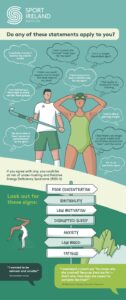
Infographic 1: Do any of these statements apply to you?
Why is this topic important?
Following the publication of the first IOC consensus statement on REDs in 2014 (1), and an updated statement in 2018 (2), a copious amount of research has been conducted over the last decade. The most recent IOC REDs consensus update in 2023 highlighted that >170 original research articles have been published around REDs (3). Our knowledge of the topic is ever-expanding from the development of clinical assessment tools to help with early identification and clinical diagnosis and the development of updated health and performance models. Educating athletes and coaches and the wider sporting environment / family about the risks of low energy availability, under-fueling and REDs is important. Therefore, the aim was to raise awareness of REDs and the associated health and performance implications and to develop educational resources to support athletes, coaches, practitioners, and the wider sporting community on the topic.
How did the multidisciplinary team go about this?
Previous research conducted in collaboration with the Irish Research Council, University College Dublin, and Sport Ireland Institute, highlighted that 24% and 40% of active males and females were at risk of LEA across a range of sports and sporting levels in Ireland (4, 5). These prevalence rates are comparable to other international studies investigating elite male and female ballet dancers (6) and Olympic level athletes (7). We looked specifically at active individuals across an array of sports to determine the extent of the problem. We further identified that those females at risk were more likely to be competing at an elite or sub-elite level (5).
Therefore, the infographics below were developed by a multidisciplinary team at Sport Ireland Institute including Physiotherapy, Medicine, Nutrition and Performance Psychology. They were developed to aid the education and discussion of RED-s among our elite cohort of athletes and coaches and provide educational resources to the wider National Governing Bodies. Each practitioner researched their specific area about REDs and monthly meetings were set up in Sport Ireland Institute to brainstorm, develop and finalise the content for the infographics before piloting with coaches and athletes for feedback on understanding and clarity of the content.
The infographics provide information on REDs (Infographic 2), the common signs and symptoms of REDs, the importance of balancing your training, nutrition, and recovery strategies (Infographics 3 & 4), some thought processes that may occur relating to REDs and the hormonal implications of REDs on reproductive and bone health. There is also information on key nutrients for bone health and performance (Infographic 5).
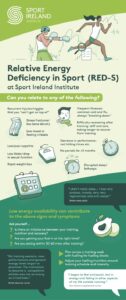
Infographic 2: Information on REDs
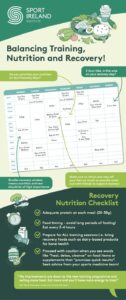
Infographic 3: Balancing training, nutrition and recovery
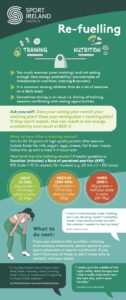
Infographic 4: Refuelling
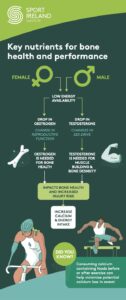
Infographic 5: Key nutrients for bone health and performance
A pilot study was undertaken with athletes and coaches to establish clarity and understanding of the infographic content for online administration and for dissemination. Feedback was incorporated into the current infographics to enhance clarity before use by practitioners.
What are the key take-home points?
The REDs infographics are useful for practitioners to use when delivering education to athletes and coaches. They have been shared among National Governing Bodies of Sport in Ireland and have also been utilised as part of educational discussions for high-performance athletes and coaches. They are also available for download on the Sport Ireland Institute website (RED-s | Sport Ireland). Furthermore, the infographics have been disseminated by our MDT to support REDs education workshops for Bodywhys, the eating disorders association of Ireland (Bodywhys | Athletes & Sport).
Addressing the lack of understanding and creating an open discussion on REDs may help minimise LEA risk rates among athletes and may positively impact health and performance outcomes.
Authors:
Ms Julianne Ryan, Dr Danielle Logue, Ms Jessie Barr, Dr James O’Donovan, Prof Sharon Madigan, Ms Sarah Jane McDonnell.
All authors are from Sport Ireland Institute, National Sports Campus, Dublin, Ireland.
References:
- Mountjoy, M., Sundgot-Borgen, J., Burke, L., Carter, S., Constantini, N., Lebrun, C., Meyer, N., Sherman, R., Steffen, K., Budgett, R., & Ljungqvist, A. (2014). The IOC consensus statement: beyond the Female Athlete Triad–Relative Energy Deficiency in Sport (RED-S). British journal of sports medicine, 48(7), 491–497. https://doi.org/10.1136/bjsports-2014-093502
- Mountjoy, M., Sundgot-Borgen, J. K., Burke, L. M., Ackerman, K. E., Blauwet, C., Constantini, N., Lebrun, C., Lundy, B., Melin, A. K., Meyer, N. L., Sherman, R. T., Tenforde, A. S., Klungland Torstveit, M., & Budgett, R. (2018). IOC consensus statement on relative energy deficiency in sport (RED-S): 2018 update. British journal of sports medicine, 52(11), 687–697. https://doi.org/10.1136/bjsports-2018-099193
- Mountjoy, M., Ackerman, K. E., Bailey, D. M., Burke, L. M., Constantini, N., Hackney, A. C., Heikura, I. A., Melin, A., Pensgaard, A. M., Stellingwerff, T., Sundgot-Borgen, J. K., Torstveit, M. K., Jacobsen, A. U., Verhagen, E., Budgett, R., Engebretsen, L., & Erdener, U. (2023). 2023 International Olympic Committee’s (IOC) consensus statement on Relative Energy Deficiency in Sport (REDs). British journal of sports medicine, 57(17), 1073–1097. https://doi.org/10.1136/bjsports-2023-106994
- Logue, D. M., Madigan, S. M., Melin, A., McDonnell, S. J., Delahunt, E., Heinen, M., & Corish, C. A. (2021). Self-reported reproductive health of athletic and recreationally active males in Ireland: potential health effects interfering with performance. European journal of sport science, 21(2), 275–284. https://doi.org/10.1080/17461391.2020.1748116
- Logue, D. M., Madigan, S. M., Heinen, M., McDonnell, S. J., Delahunt, E., & Corish, C. A. (2019). Screening for risk of low energy availability in athletic and recreationally active females in Ireland. European journal of sport science, 19(1), 112–122. https://doi.org/10.1080/17461391.2018.1526973
- Staal, S., Sjödin, A., Fahrenholtz, I., Bonnesen, K., & Melin, A. K. (2018). Low RMRratio as a Surrogate Marker for Energy Deficiency, the Choice of Predictive Equation Vital for Correctly Identifying Male and Female Ballet Dancers at Risk. International journal of sport nutrition and exercise metabolism, 28(4), 412–418. https://doi.org/10.1123/ijsnem.2017-0327
- Drew M.K., Vlahovich N., Hughes D., Appaneal R., Peterson K., Burke L., Lundy B., Toomey M., Watts D., Lovell G. (2017). A multifactorial evaluation of illness risk factors in athletes preparing for the Summer Olympic Games. J. Sci. Med. Sport. 20, 745–750. doi: 10.1016/j.jsams.2017.02.010.